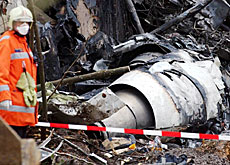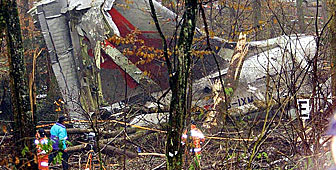Crossair crash caused by pilot error

A report into a Crossair crash near Zurich two years ago that killed 24 people says serious pilot errors were to blame for the accident.
Switzerland’s Aircraft Accident Investigation Bureau also criticised shortcomings of the aircraft operator, Crossair.
The Federal Prosecutor’s Office said on Tuesday that it had opened a criminal investigation into possible negligent homicide and grievous bodily harm by negligence.
The accident report confirmed that the pilot of the Jumbolino Avro RJ-100 jet dropped below the minimum descent altitude, ignoring automatic alarm signals.
The plane, which was flying from Berlin to Zurich on the night of November 24, 2001, crashed into woodland just short of the runway, killing 24 of the 33 people on board.
The report said the 57-year-old pilot of Crossair flight LX 3579 was too tired to concentrate fully or make crucial decisions.
The pilot had been working for more than 13 hours when the crash occurred and had also exceeded maximum duty times in the two days before the accident.
But the report also said the pilot had certain “weaknesses”, which Crossair had overlooked, and he had repeatedly failed exams.
Pilot was tired
The Aircraft Accident Investigation Bureau concluded that the pilot’s “ability to concentrate and take appropriate decisions, as well as his ability to analyse complex processes were adversely affected by fatigue”.
It also blamed the co-pilot for not doing anything to rectify the pilot’s error on his landing approach.
The report also criticised a lack of safety controls and poor pilot training at Crossair, which formed the backbone of the new national carrier, Swiss.
It added that senior managers at the airline should have identified that the pilot was not in a fit state to fly.
But Swiss CEO André Dosé – who was in charge of Crossair at the time of the accident – said he had no plans to resign following publication of the crash report.
“Neither I nor any member of my team have any plans to step down,” Dosé said at a press conference on Tuesday.
“At this moment in time we have not been accused or found guilty of anything,” he added.
Poor training
Officials said training deficiencies unearthed by the crash investigation were not isolated. “We know of at least 40 similar cases,” the report said.
Other factors that contributed to the crash included the fact that there was no alarm system on Zurich’s runway 28 to warn pilots if they were flying too low. The system for measuring visibility at the airport was inappropriate for the runway.
Investigators noted that the range of hills over which the plane flew was not marked on the map the pilots were using.
The Federal Office for Civil Aviation (FOCA) was also singled out for failing to supervise Crossair’s training programme.
And the Swiss air traffic control agency, Skyguide, was criticised for only having one person on duty at the time of the accident instead of the usual four.
Safety record
Even though Swiss admitted that the pilot was to blame for the crash, it defended its safety record, saying it had always met all national and international safety requirements.
Swiss said it was not sure why the “highly experienced” captain had dropped below the minimum height.
The carrier pointed out that since the accident it had introduced a new flight safety programme covering recruitment, training, checks, workflow and procedures throughout its operations.
The company has also taken the unusual measure of creating its own Flight Safety Advisory Board.
All the recommendations made by the investigators had already been put into practice, the company said.
Swiss said it had paid compensation to the families of the victims but was still facing lawsuits in Switzerland, Germany and Israel.
An investigation into a Crossair plane crash in January 2000 in which ten people died also identified pilot error as the cause of the accident.
swissinfo with agencies
Crossair flight LX3579 from Berlin crashed at 22.08pm on its approach to Zurich airport on November 24, 2001.
Twenty-four people, including three crew members, were killed in the crash.
Nine people survived the crash.
The latest report says the captain dropped below the minimum flight height but it does not reveal why the safety net around the aircraft failed to function.

In compliance with the JTI standards
More: SWI swissinfo.ch certified by the Journalism Trust Initiative












You can find an overview of ongoing debates with our journalists here . Please join us!
If you want to start a conversation about a topic raised in this article or want to report factual errors, email us at english@swissinfo.ch.